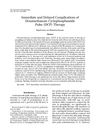Cyclophosphamide-Associated Acneiform Drug Eruption in a Patient with Multiple Myeloma
August 2011
in “
Journal of the American Academy of Dermatology
”

TLDR A patient's skin eruption was caused by the cancer drug cyclophosphamide and improved after stopping the drug.
A 67-year-old male patient with multiple myeloma developed a pustular eruption on his scalp, face, neck, upper chest, and back after starting treatment with cyclophosphamide and dexamethasone. The eruption, which began three days after the initiation of cyclophosphamide, was characterized by erythematous pustules and was most prominent on the face. Histologic examination revealed a neutrophil-rich infiltrate around hair follicles, consistent with a neutrophilic drug reaction. Other potential diagnoses such as steroid acne and pityrosporum folliculitis were ruled out due to the distribution of the lesions and absence of yeast overgrowth. Upon discontinuation of cyclophosphamide and initiation of topical fluocinonide emollient cream, the eruption receded within one day and completely resolved in six weeks. The patient's medical oncologist replaced cyclophosphamide with oral lenalidomide while continuing oral dexamethasone, and no further skin complaints were reported. This case suggests that cyclophosphamide should be considered in the differential diagnosis for patients presenting with acneiform eruptions.




